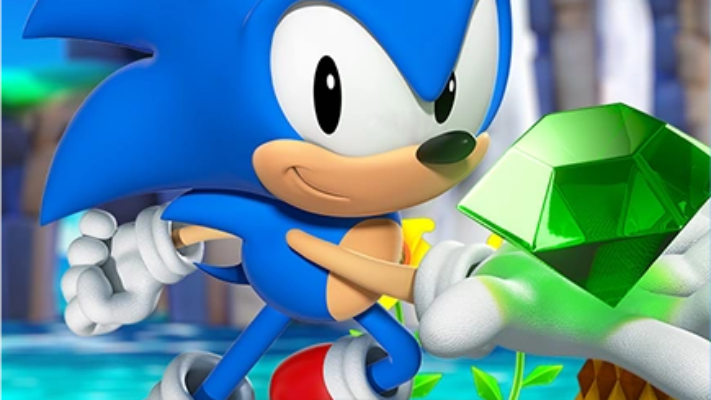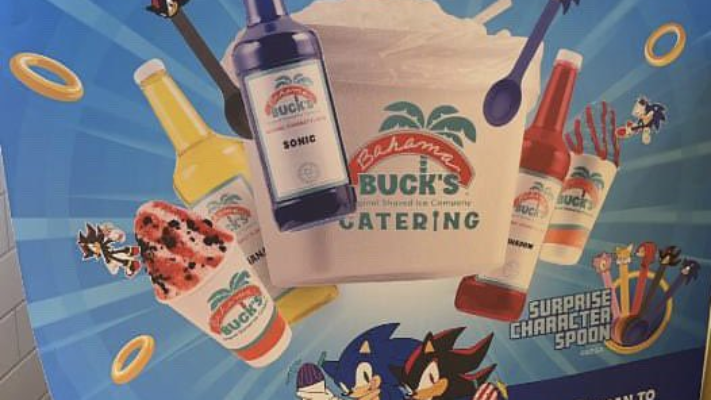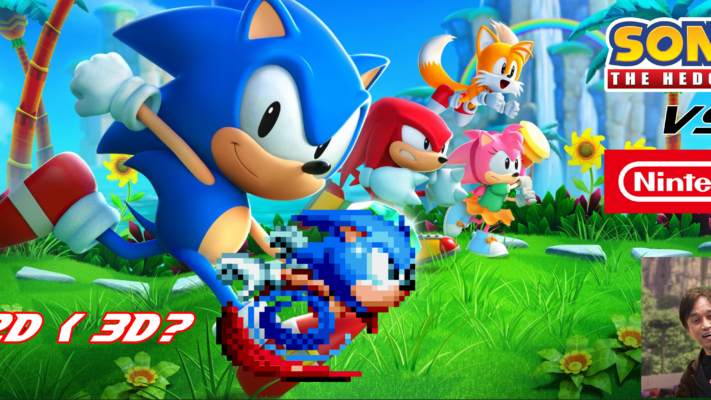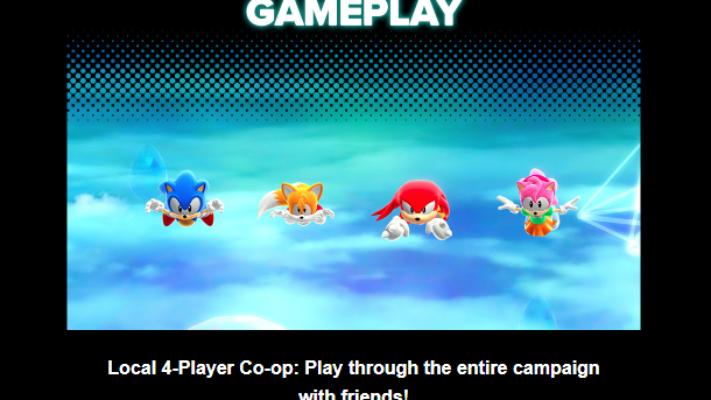Continuing with Game Informer’s coverage of Sonic Superstars, the first six zones were also exclusively revealed to the publication. While we already had a good look at the first two zones, Bridge Island and Speed Jungle Zone, there were a lot more extra details than meet the eye. Let’s dive in and take a look at the six Zones that were previewed.

Bridge Island Zone
The first zone of the game, while it’s not Green Hill, the aesthetic inspiration is still on full display here with its palm trees, checkerboard patterns, and sunflowers, while the level design is different and even has wall run sections and opportunities where you can use your new Emerald Powers to swim up waterfalls. Takashi Iizuka of Sonic Team calls this Zone “that quintessential Sonic-y feel. We see the water; it’s got that oceanside, beachside, waterfront kind of feel, it’s got bright colors, and it’s very fun to run around in. It feels very true to the Classic Sonic games. It’s our very standard, go-to, ‘this-is-a-Sonic-experience’ zone.” The Zone also features familiar enemies, including Crabmeat, Buzz Bomber, and Chopper.
According to Brian Shea, the game rewards your exploration with power-ups and other points of interest, with Iizuka-san even mentioning that “Multi-pathways are one of the critical elements in designing a Classic Sonic 2D platformer. When you combine Sonic’s speed with side-scrolling, there’s no way to avoid sudden falls or places where you can’t see where you will land. If you die every time that happens, you won’t want to go fast. That’s why multi-pathways are essential for level design; even if you fall, there’s another route below, or if you play well, you can get to the path above.” Brian also described finding the classic standard shield that protects you from one hit and the power sneakers that increase your speed temporarily but also found a new power-up, a magnet, that pulls nearby rings to the player. Giant blue and gold rings can also be found while exploring the stages, and touching them will teleport you to the game’s Special Stages similarly to Sonic 3 & Knuckles.

In Act 2, the stage transitions from daytime to sunset, which immediately differentiates it from the first act, again, just like in Sonic 3 & Knuckles.
That kind of dynamic change all started with Sonic 3. That system was put in place because for Sonic 1 and 2, things were kind of static, and you’d have the same kind of fun and same gameplay in Act 1 just carry over into Act 2. But it was really impactful when we got to Sonic 3 to be able to change the visuals and also change the gameplay style to bring this variation in Act 1 and Act 2, and as a [player], that dynamic shift was very fun. Even as a designer, it was a lot of fun to create these drastic changes in the world, drastic changes in gameplay that created that fun element when you play through from Act 1 to Act 2.
Takashi Iizuka
Each Act also has its own boss, with this Zone’s Act 1 boss being a chase sequence involving a giant fish robot and Act 2 being against Eggman in one of his mechs.

Speed Jungle Zone
For the Sonic games that I create, I have kind of a methodology for how I create things, and I always want the second stage to be this fun, speedy, fast experience. So, the first zone is going to be the traditional, standard, very core, ‘this-is-a-Sonic-game.’ But that second stage, we want to be speedy and fun and fast. Speed Jungle is a good execution on this idea. It’s getting people in that fast, fun experience to say, ‘Oh wow, yeah, this is a Sonic game. This is what’s different about Sonic games!’
Takashi Iizuka
While we’ve already had an extensive look at this zone, including the Act 1 and Act 2 bosses, Brian came across a section of a previously reported feature which was exclusive levels for each of the playable characters. In his hands-on time, Brian played one of Sonic’s exclusive levels, aptly named “Act Sonic,” in which you run through the stage with Fang terrorizing you throughout the level, which ends in a chase sequence where you have to run away from him.
One other fun thing about Speed Jungle is that it starts introducing the storytelling elements and what’s going on in the world as you’re playing the game. I think a lot of people have this real nostalgic feel for Fang. Some people may not know, but some people may be like, ‘Oh my god, Fang’s back!’ And in the storytelling moments, we get to see Fang attacking Sonic and see that kind of storytelling play out in Speed Jungle.
Takashi Iizuka
The world map also seems to work like it did in Sonic Generations, where you run around a 2D plane selecting your desired stage and changing characters. In this world map, there’s also a customization shop where you can buy parts for the head, body, arms, legs, accessories, color, pattern, and something called “prototype” using the medals that you collect throughout the levels in the game.

Sky Temple Zone
Zone one and zone two are really there to have that fun, boom, jolt of excitement, but zone three is there as a technical stage. We wanted to introduce people to this floating, ancient world. It’s floating in midair and we have all these fans and these other contraptions that are blowing things up and keeping things afloat. [You’re] able to cross these bridges that are breaking underneath you. [We] really made a zone that’s going to be a fun, technical challenge for people who are into that kind of platforming action.
Takashi Iizuka
This Zone seems to have taken inspiration from classic Zones like Sky Sanctuary and Flying Battery, with even more familiar enemies littering the stages from those Zones as well as a brand new cloud-shapped enemy. According to Brian, the Zone also features platforming sequences with blocks that extend when you step on them, plus a repeated minigame reminiscent of the classic game Breakout, where your character becomes a ball, and you need to aim to break through various bricks.

This Zone also sets itself apart from tradition, being a Zone with just one, but very long, Act – taking Brian 9 minutes to finish.
A lot of the Classic games follow the standard format we have of Act 1 followed by Act 2, Act 1 followed by Act 2, and it kind of creates a rhythm and tempo for the Classic games. But the team wanted to break that tempo up and have the gameplay with a different beat. So, some of the zones are going to have maybe three acts, and some of the zones will only have one act. It’s changing around the format just a little bit, trying to get a different feel from the players when they’re playing through the game.
Takashi Iizuka
Near the end of the stage, a storm hits and everything starts floating, similarly to Sonic Adventure’s Windy Valley, but unlike that game, the storm persists until the end of the Act where you have another boss fight against Eggman.


Pinball Carnival Zone
The next Zone in Sonic Superstars is Pinball Carnival Zone, which utilizes the franchise’s familiar carnival and casino aesthetic. The entire Zone is filled with (as you might have guessed) pinball tables that you’ll have to navigate through by utilizing the game’s physics in order to reach the end.
Pinball Carnival is that real Sonic-y pinball stage that we like putting in the games. It’s a pinball amusement park. It’s this merging of an amusement park with those pinball elements. The first act, it’s daytime; it’s bright, it’s fun, you get to really enjoy getting bounced around having that pinball experience, but then when it becomes nighttime, we see a different tone come through.
Takashi Iizuka
The Act 1 boss is a clown robot and the Act 2 boss is Eggman in a roulette wheel that shoots out bombs at the player. In Act 2, the time of day changes again, this time to nighttime, where the stage becomes a haunted carnival with the enemies taking on a more ghost-like appearance.
We’re at an amusement park, but now it’s not daytime. It’s now nighttime, and things are a little bit different. Being able to still have people play that pinball experience but get two kinds of styles out of the pinball feel is what we wanted to do with Pinball Carnival.
Takashi Iizuka

Lagoon City Zone
Lagoon City is the two acts where the Water Emerald Power is going to be super helpful. Act 1 and Act 2 have water as the core element in design. When we think about water zones, it’s usually, ‘Oh, it’s going to be a slow tempo. I’m going to be underwater,’ but actually, for Act 1, what we want to do is incorporate high speed and water all in the same design. So, you’re getting that high-speed Sonic feel, but we’re also incorporating water into Lagoon City.
Takashi Iizuka
The first boss in the Zone is the one you can see below, a giant jellyfish robot that drops smaller badniks.

Act 2, that’s where you’re really going to want to be using the Water Emerald Power just to make sure you can get through and play it however you want to play with that power. Using that Water Emerald Power is highly recommended in Lagoon City.
Takashi Iizuka
While Act 1 features more high-speed antics like waterslides, Act 2 is more underwater action oriented, featuring air bubbles similar to those in Sonic Mania’s Hydrocity Zone. The boss in this level is Eggman in a crusher machine, with the first phase being a vertical fight, which transitions to a horizontal one in the second phase.
We thought about the boss fights like Sonic 3, with a mech sub-boss after Act 1 and an Eggman boss after Act 2. I wrote boss fight specifications for Sonic 3, drawing on that experience to work with Arzest staff on the design.
Takashi Iizuka
Amy also has an exclusive Act in this zone, which involves blasting through fruit and fruit-themed enemies with her hammers. Near the end of this stage, you find Trip and have to carry her to the end of the level.
Sand Sanctuary Zone
The last of the previewed Zones. A desert like Zone that looks similar to Sonic 3 & Knuckles’ Sandopolis Zone.
Sand Sanctuary is our desert-themed stage, but from the storytelling perspective, one of the key points is the animals have become jumbo-sized extra large. One of the ideas that we had when thinking about what animals could we make really large and put in these zones that would be really cool was a snake. So, we wanted to that snake motif, or the idea of a snake, and implement that into the design of Sand Sanctuary.
Takashi Iizuka
The next Zone in the game is Press Factory Zone, however, Brian did not get a chance to have hand-on time with it.
Check out more screenshots below!




That’s it for now, but make sure to stay tuned to Sonic City for more Sonic Superstars News and Updates!
Source: Game Informer
Discover more from Sonic City ⋆★ Sonic the Hedgehog News, Media, & Community ★⋆
Subscribe to get the latest posts sent to your email.







